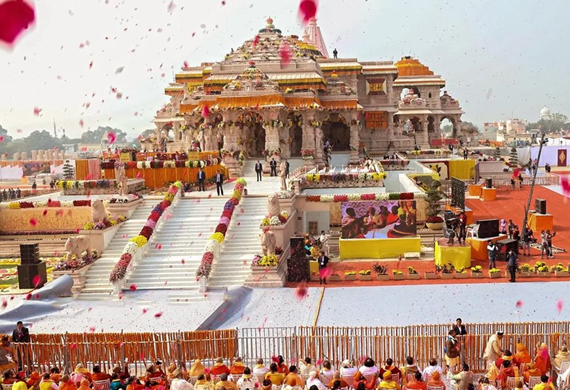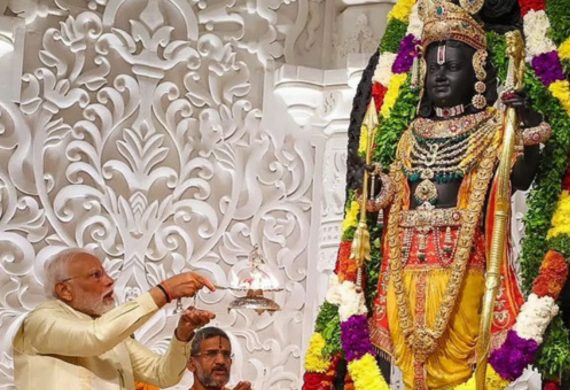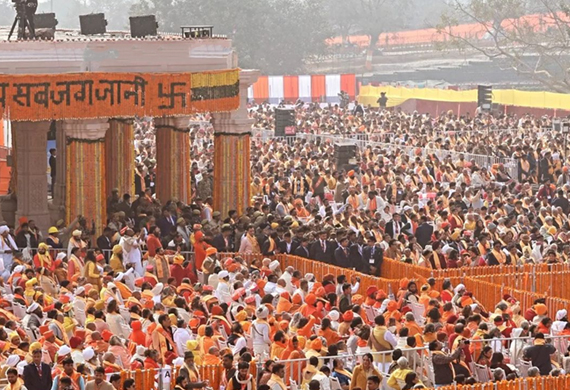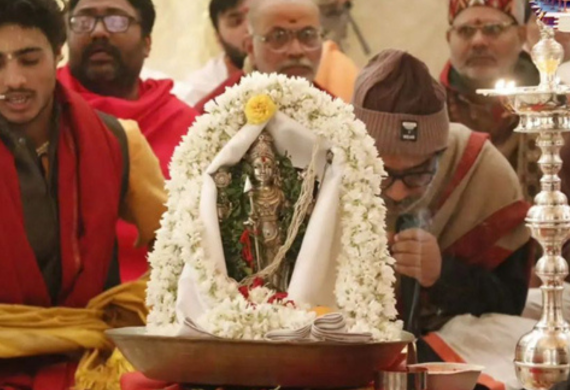
Ram Mandir Pran Pratishtha: Historic Event Unites Hearts of Bharat
By: Supraja Mohanty, Correspondent
The Ram Mandir Pran Pratishtha celebration in Ayodhya comes as an important spiritual event that will be remembered in history for its significant impact on the country’s social and political fabric. Here is everything you need to know from the ceremony details to who attended the much talked about event.
On January 22, 2024, at the hallowed site of Ayodhya, the air was filled with devotion and anticipation as the Ram Mandir Pran Pratishtha, or consecration ritual, took place. The significance of this historic occasion went beyond brick and mortar; it dug into the very heart of faith and the cultural thread that weaves India's variegated tapestry together.
The ambiance was solemn and reverent as the consecration ceremony began between 12:15 PM and 12:45 PM IST. The entire nation, regardless of geography, was joined in spirit, watching a moment that would be remembered for centuries. In the heart of Ayodhya, a divine link was made, signifying the realization of a timeless desire.
Prime Minister Narendra Modi, a man of the people, took on a role beyond politics on this auspicious day. His adherence to the ceremonies, which included an 11-day fast during which he lived entirely on coconut water and slept on the floor, revealed a deep understanding of the event's spiritual significance. The pinnacle of this sacrifice was the completion of the Ram Mandir Pran Pratishtha Ceremony, which represented a harmonic combination of political leadership and spiritual devotion.
Understanding Pran Pratishtha & its Essence

The notion of Pran Pratishtha extends beyond the physical structure of the temple. It is a religious rite that converts an idol into a living god capable of receiving prayers and showering blessings on believers. In the case of the Ram Mandir, this transforming celebration included intricate ceremonies culled from the Vedas and Puranas, each with its own profound meaning.
The Shobha Yatra, a parade of the idol through the streets, signalled the start of the transformational journey. The bystanders' love went to the idol, imbuing it with heavenly might. Adivas ritual also took place in later phases to submerge the idol in various materials like water and grain, representing healing and cleansing.
The ceremonial wash or Abhishek, which were done with a variety of materials, culminated in the Netron-meelan, or opening of the deity’s eyes. This final process consisted of chants requesting several Gods to enliven different features of the idol. Anjan's symbolism, placed around the eyes with a gold needle, represented a moment of heavenly awakening, making the idol more sensitive to worshipers.
The significance of Pran Pratishtha stems not only from its physical structure, but also from the conceptual relationship between the deity and the devotee, as stated in the Vedas and Puranas.
Notable Female Figures at the Ceremony

The Pran Pratishtha ceremony at the Ram Mandir was attended by a notable group of outstanding women, each of whom contributed to the occasion in their different disciplines. Here are some of the prominent female individuals that attended this historic event:
Pratibha Patil, the former President of India, added a touch of statesmanship to the occasion by representing the country's highest office.
Sangeeta and Sonali Jaitley, the late former Union Minister Arun Jaitley's wife and daughter, provided a sad touch to the ceremony by reflecting a stalwart's political legacy.
Sumitra Mahajan and Meira Kumar, Former Lok Sabha Speakers Sumitra Mahajan and Meira Kumar represented the nation's parliamentary history.
Diplomats Veena Sikri and Lakshmi Puri attended the event, representing the nexus between diplomacy and culture.
Sudha Murthy, an author and philanthropist, exemplified the intellectual and compassionate aspects of Indian civilization via her literary and humanitarian works.
G20 Sherpa Amitabh Kant, with her strategic acumen, helped to ensure worldwide presence at the ceremony.
Mithali Raj, captain of the Indian women's cricket team, gave a sporting element to the event, demonstrating the power and perseverance of female athletes.
Badminton players Saina Nehwal and PV Sindhu represented the spirit of success at the occasion.
Sprint queen PT Usha, a superstar in Indian sports, attended the ceremony, representing the victory of devotion and endurance.
Bollywood stars Alia Bhatt, Katrina Kaif, and Kangana Ranaut brought elegance to the celebration by representing the entertainment sector.
Legendry actresses Madhuri Dixit and Hema Malini, both legends of Indian film, added elegance and grace to the event.
Dipika Chikhlia, who played Goddess Sita in the legendary Ramayan TV series, brought a sense of grandeur to the gathering.
The ceremony's spiritual aura was enhanced by the melodious voices of singers Shreya Ghoshal and Anuradha Paudwal.
These ladies, each a luminary in her own way, transformed the Pran Pratishtha ritual from a religious occasion to a celebration of women's unique and important contributions in constructing India's cultural fabric.
The Global Impact of the Ram Mandir Pran Pratishtha

The dedication of the Ram Mandir in Ayodhya is more than a national event; it is a global phenomenon that resonates with the Indian diaspora and enthusiasts of Indian culture across the world. The event was attended by a wide group of people, including actors, legislators, bureaucrats, businesspeople, spiritual leaders, and sports celebrities, demonstrating the inclusiveness of this historic occasion.
PM Modi's invitation for all Indians to light diyas and celebrate Diwali is more than simply a religious holiday, but also a cultural celebration that crosses religious lines. This event has a worldwide influence since it highlights India's cultural history and invites the world to see the peaceful coexistence of tradition and modernity.
The Ram Mandir, which rises tall in Ayodhya, represents more than simply a physical structure; it also represents the persistence of religion, the continuation of cultural narratives, and the force of unification.
The journey that began with legal and political events concludes in a moment that is etched into a nation's collective consciousness, leaving an everlasting impact on Indian cultural history.
Congratulations from Women Entrepreneur India to everyone on this emotional milestone!






